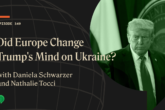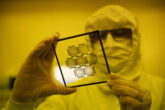October 11, 2021
Key takeaways from the inaugural EU-U.S. Trade and Technology Council meeting
On September 29, the European Union and United States hosted the inaugural Trade and Technology Council (TTC) meeting in Pittsburgh, Pennsylvania. As an official stated in advance of the meeting, analysts should not expect fireworks from the inaugural meeting. While there were no fireworks and few tactical policy recommendations, the resulting joint statement outlined the United States and European Union’s priorities moving forward in trade and technology. Several issues topped the agenda in the inaugural meeting. How these issues are addressed in the upcoming working group meetings will outline the path forward for transatlantic cooperation across a variety of areas.
The TTC joint statement identifies semiconductors as a top priority for the transatlantic allies. Shortages across the global economy and geopolitical concerns about manufacturing concentration in Taiwan, who holds 92% of leading-edge capacity, have necessitated improving semiconductor supply chain resiliency in the United States and Europe. To this end, the U.S. Congress passed the CHIPS Act in January to elevate the priority of semiconductors, and recently the U.S. Senate passed a bill appropriating $52 billion to improve semiconductor supply chain resiliency. Similarly, the EU Commission President Ursula von der Leyen outlined the EU’s goals for semiconductor supply chain resiliency in her State of the Union address.
As the United States builds AI regulations, the United States should strive to align its AI Risk Management Framework with the European Union’s Artificial Intelligence Act.
Although von der Leyen’s speech outlined the importance of semiconductor production, Europe’s semiconductor strategy remains unclear. The absence of a clear strategy and prioritization from Europe threatens to hobble transatlantic cooperation in this domain. Without a clear vision of Europe’s priorities or goals, the partners are unable to determine complementarity in their strategies or how to chart a course forward for cooperation. Moving forward, Europe must define their overarching goals in this space. Only then can the TTC’s supply chain resiliency working group coordinate the transatlantic partner’s efforts and subsidies to create the most impact, while avoiding a subsidy race between the United States and Europe.
Developing and implementing trustworthy artificial intelligence was another focus area in the joint statement. The United States and European Union acknowledged the importance of human-centered AI and recognized each other’s regulatory regimes. As the United States builds AI regulations, the United States should strive to align its AI Risk Management Framework with the European Union’s Artificial Intelligence Act. Recognizing their respective regulatory frameworks in the joint statement is a good first step toward more aligned regulations on artificial intelligence, which are critical to counter authoritarian uses of artificial intelligence.
Read the full article from Encompass Europe.
More from CNAS
-
Did Europe Change Trump's Mind on Ukraine?
The Trump administration made a major move this week in its announcement of sanctions on major Russian oil companies Rosneft and Luke Oil, along with 31 subsidiaries. This fol...
By Andrea Kendall-Taylor & Jim Townsend
-
Transatlantic Security / Energy, Economics & Security
Bloomberg Tech | Day 1 | Opening Night DebateGeoffrey Gertz, senior fellow, joined Bloomberg Tech's opening night debate and attempted to answer the question “Is Europe Too Late to Compete in the Chip War?” The U.S. and ...
By Geoffrey Gertz
-
A Tale of Two Russias: Views from Former Intelligence Officers
Four years into its war in Ukraine, Russia continues to escalate attacks on the Ukrainian population while also dialing up its hybrid campaign against Europe. In the last six ...
By Andrea Kendall-Taylor, Jim Townsend & Peter Schroeder
-
Trump Needs to ‘Make Putin Hurt’ to Achieve Peace
“Trump’s going to have to really make it hurt, and these Tomahawks can be a pretty good tool to bring some hurt to Putin.” In order for Trump to replicate the Gaza ceasefire w...
By Jim Townsend




